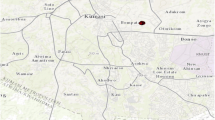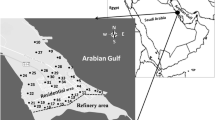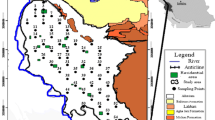Abstract
An imbalance in the environment’s composition leads to significant effect on human activities such as farming. Of importance are heavy metals which are introduced anthropogenically or naturally. This calls for environmental monitoring and subsequent remediation if needed. An environmental monitoring exercise was conducted on Ikwo soils of Ebonyi State, eastern Nigeria with the aim of determining concentration levels for possible remediation. A total of 18 soil composite samples taken at 0–50 cm below soil surface from fallowed and cultivated soils not fertilized were subjected to heavy metal analyses and fertility indices like: organic matter (OM), cation exchange capacity (CEC), % total nitrogen (%TN), organic carbon (OC), and salinity. A correlation at 95% confidence level between geo-accumulations (Igeo) of the various heavy metals with salinity, OM, and CEC of the sampled soils reveals that Igeo could be a contributing factor to the fertility status of the soils. With the aid of inductively coupled plasma atomic emission spectrophotometer (ICP-AES), the distribution pattern was determined as Mn> Fe> Zn>Cu> Mo> Cd> V>Hg>Ti> Ni>Bi> Pb> Co>Ag>Au> Cr>Pd>Pt. The Igeo of the heavy metals in the study area varied from heavily to extremely contaminated levels. A remediation exercise was recommended on Ikwo soils due to their high salinity level and low CEC.



Similar content being viewed by others
References
Abdel-Dayem, S. (2005). Understanding the social and economic dimensions of salinity. Proceedings of the International Salinity Forum, Riverside, CA. April 25-27, 2005,1–4.
Angulo, E. (1996). The Tomllinson pollution load index applied to heavy metals, mussel watch data; a useful index to assess coastal pollution. Science of the Total Environment, 187(1), 19–56. https://doi.org/10.1016/0048-9697(96)05128-5.
Arifin, S., Maria, G., Tommy, L., Gunnar, J., & Prosun, B. (2017). Arsenic concentrations in local aromatic and high-yielding hybrid rice cultivars and the potential health rice: a study in an arsenic hotspot. Environment Monitoring Assessment, 189, 184.
Bernhard, A. Z., Pichit, P., Mike, J. M., & Gill, C. (2004). Heavy metals in soils and crops in southeast Asia. 2. Thailand. Environmental Geochemistry and Health, 26, 359–371.
Boularbah, A., Schwartz, C., Bitton, G., & Boulabah, J. L. M. (2005). Heavy metals contamination from mining sites in south Morocco: use of a biotest to assess metal toxicity of tailings and soils. Chemosphere, 63, 802–810.
Chukwuji, M. A., Iwegbue, G. A., Nwajei, G. E., & Isirimah, N. O. (2006). Characteristic of levels of heavy metals in sediments and dredged sediments of a municipal creek in the Niger delta, Nigeria. Environmentalist, 26, 129–133.
Chukwuma, C. (1993). Cadmium, lead and zinc from terrestrial plants in Enyigba lead and zinc mine: search for a monitoring plant specie in trace element distribution. Bulletin of Environmental Contamination and Toxicology, 51(5), 665–671.
Francisco, J.V., Luciano, M., Miguel, Q., Antonio, D. and Elias, F. (2016). Control of salinity: principle of agronomy for sustainable agriculture. Springer International Publishing, 295–320.
Franzaring, J., Mbaka, G. E., Amebe, T. F., Nkengafac, J. N., Schlosser, S., & Fanmeier, A. (2017). Foliar nutrient and metal levels of crops in the mount Cameroon area—reference values for plant nutrition and environmental monitoring. Environmental Monitoring Assessment, 189(4), 186. https://doi.org/10.1007/s10661-017-5896-4.
Gilbert-Diamond, D., Cottingham, K. L., Gruber, J. F., Punshon, T., Sayarath, V., Gandolfi, A. J., Baker, E. R., Jackson, B. P., Folt, C. L., & Karagas, M. R. (2012). Rice consumption contributes to arsenic exposure in US women. Proceedings of the National Academy of Sciences of USA, 108(51), 20656–20660.
Hernandez, L., Probsta, A., Probsta, J. L., & Ulrich, E. (2003). Heavy metal distribution in french forest soils: evidence for atmospheric contamination. Science of the Total Environment, 312(1-3), 195–219. https://doi.org/10.1016/S0048-9697(03)00223-7.
International Institute of Tropical Agriculture (IITA) (1981) Automated and semi automated methods for soil and plant analysis. Manual series No.7.
Oje, A. O., Peter, N. U., Ikechukwu, N. E. I., & Uchechukwu, U. N. (2010). Environmental pollution levels of lead and zinc in Ishiagu and Uburu communities of Ebonyi State, Nigeria. Bulletin of Environmental Contamination and Toxicology, 85(3), 313–317. https://doi.org/10.1007/s00128-010-0082-1.
Ololade, I. A. (2014). An assessment of heavy metals contamination soils within auto mechanic workshops using enrichment and contamination factors with geoaccumulation indexes. Journal of Environmental Protection, 5(11), 970–982. https://doi.org/10.4236/jep.2014.511098.
Oti Wilberforce, J.O., Nwabue, F.I. and Afiukwa, J.N. (2012). Analysis of heavy metals in soils of Enyigba and Abakaliki using proton induced X-ray emission spectroscopy. Environment and Pollution,1(2), 183-193
Pastor, J., & Hernandez, A. J. (2012). Heavy metals salts and organic residues in old solid urban waste landfills and surface waters in their discharge areas: determinants for restoring their impact. Journal of Environmental Management, 95, 42–49.
Rafie, R. M. (2012). Removal of heavy metals from waste water using black teawaste. Arab Journal of Science and Engineering, 37, 1505–1520.
Ryszard, M., Joanna, K., Michal, G., Pawal, Z., Agnieska, J., Tomasz, Z., Wojciech, K., Maryla, T., & Kalina, O. (2017). Assessment of heavy metals contamination in surface layers of Roztocze national park forest soils (SE Poland) by indices of pollution. Chemosphere, 168, 839–850.
Singh, S., & Kumar, M. (2006). Heavy metal load of soil, water and vegetables in Peru urban Delhi. Environmental Monitoring and Assessment, 120(1-3), 79–91. https://doi.org/10.1007/s10661-005-9050-3.
Smart, C. O., Anthony, C., Sadrack, F. T., & Theophilus, C. D. (2016). Assessment of heavy metal contamination in soils around lead-zinc mining areas in Enyigba, southeastern Nigeria. Journal Geological Society of India, 87, 453–462.
Wang, W., Lai, Y., Yuanyuan, M., Liu, Z., Wang, S., & Hong, C. (2016). Heavy metal contamination of urban topsoil in petrochemical industry city in Xinjiang, China. Journal of Arid Land, 8(6), 871–880. https://doi.org/10.1007/s40333-016-0057-0.
Yang, Z. (2009). Hofmeister effects: an explanation for the impact of ionic liquids on biocatalysis. Journal of Biotechnology, 144(1), 12–22. https://doi.org/10.1016/j.jbiotec.2009.04.011.
Zhang, J. S., De, C. X., Yan, S. C., & Zhen, Z. (2017). Heavy metals translocation and accumulation from the rhizosphere soild to the edible parts of the medicinal plant fengdan (paeonia ostii) grown on a metal mining area, China. Ecotoxicology and Environmental Safety, 143, 19–27.
Zhenwu, T., Miao, C., Jiali, C., Jing, J., Yufei, Y., Zhiqiang, N., Qifei, H., & Yanhua, L. (2017). Contamination and health risks of heavy metals instreet dust from a coal mining city in eastern China. Ecotoxicology and Environmental Safety, 138, 83–91.
Acknowledgements
The authors appreciate Oje Obinna of Environmental Toxicology and Gregory Osikakwe Ph.d of the Department of Geology, Federal University Ndufu-Alike, Ikwo, Nigeria, for their contribution to the success of this work.
Funding
This research work is financed by Nigeria Tertiary Education Trust Fund for year 2015 through the collaboration of Federal University Ndufu-Alike, Ikwo, Nigeria.
Author information
Authors and Affiliations
Corresponding author
Appendix
Appendix
Rights and permissions
About this article
Cite this article
Tyopine, A.A., Jayeoye, T.J. & Okoye, C.O.B. Geoaccumulation assessment of heavy metal pollution in Ikwo soils, eastern Nigeria. Environ Monit Assess 190, 58 (2018). https://doi.org/10.1007/s10661-017-6423-3
Received:
Accepted:
Published:
DOI: https://doi.org/10.1007/s10661-017-6423-3




